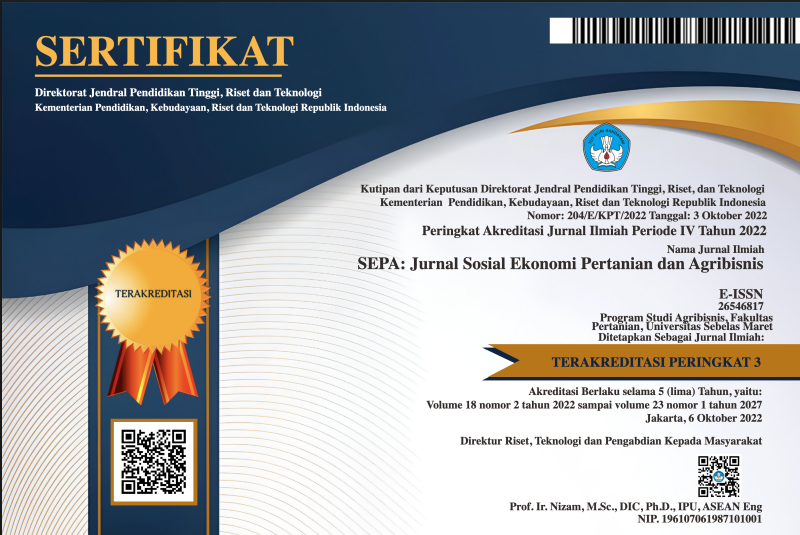ANALISIS PERWILAYAHAN DAN KONTRIBUSI KOMODITAS JERUK SIAM TERHADAP PEREKONOMIAN KABUPATEN BANYUWANGI
Abstract
Siam Oranges in Banyuwangi is spread in nine central districts. Based on production data Siam Oranges in 2013-2017, it can be seen that there is a change in districts that are the highest Siam Oranges productions each year. Based on that conditions, Siam Oranges need to be one of the commodity focuses that require the determination of strategic areas so that can be developed and it can be done by mapping the region. The aim of the study is to explain the districts that are the basis of Siam Oranges, the characteristics of the spread of Siam Oranges, and it contributes to the economy of Banyuwangi. The method used in this study is an analytical method. The data used in the study were secondary data from the Department of Agriculture, Forestry, and Plantation of Banyuwangi. Analysis of data with the LQ method, localization and specialization, and contributions will be done through the proportion formula. LQ analysis is calculated using three indicators, namely land area, production, and revenue. The results of the analysis show that the based on the average LQ value from 2013-2017 which has consistently been the base district of the Siam Oranges based on three different indicators are Bangorejo District, Purwoharjo District, Tegaldlimo District, Cluring District, and Gambiran District. Localization analysis shows that Siam Oranges are not localized in a particular district. Specialization analysis shows that none of the sub-districts of the Siam Oranges base specialize in just the Siam Oranges commodity. Contribution analysis shows that the contribution of Siam Oranges to the economy of Banyuwangi from 2013-2017 is 0,0019; 0,0041; 0,0102; 0,0050 dan 0,0020. It means low because this percentage is less than the average contribution component of economy Banyuwangi.
Keywords
Full Text:
PDFReferences
Boekoesoe, Yuriko. 2011. Analisis Perwilayahan Komoditas Mangga di Provinsi Gorontalo. Jurnal Ilmiah Agropolitan. 4 (2). 527-534.
Djarwanto. 2001. Statistik Non Parametrik Bagian 1 Edisi 3. Yogyakarta: BPFE-UGM.
Larasati, Niken. 2011. Faktor-Faktor yang Mempengaruhi Permintaan dan Penawaran Ubi Jalar serta Kontribusinya terhadap Perekonomian Jawa Timur. Skripsi. Tidak diterbitkan. Jember: Universitas Jember.
Nazir, Mohamad. 2005. Metode Penelitian. Jakarta: Ghalia Indonesia.
Mulyono, J dan Munibah, K. 2016. Pendekatan Location Quotient dan Shift Share Analysis dalam Penentuan Komoditas Unggulan Tanaman Pangan di Kabupaten Bantul. Informatika Pertanian. 25(2). 221-230.
Pasaribu, Pratama, Andi, dan Soetriono. 2009. Perwilayahan dan Strategi Pengembangan Komoditas Karet (Hevea brasillensis) di Indonesia. J-SEP. 3(3): 1-14.
Pemkab Banyuwangi. 2016. Rencana Strategis Dinas Pertanian Kabupaten Banyuwangi Tahun 2016-2021. Banyuwangi: Dinas Pertanian Kabupaten Banyuwangi
Pusat Data dan Informasi Pertanian. 2015. Komoditas Pertanian Hortikultura: Jeruk. Jakarta: Kementerian Pertanian.
Soetriono. 1996. Sektor Basis Kedelai sebagai Pendukung Agroindustri di Kecamatan Ambulu Kabupaten Jember. Agrijurnal. 2(3). 1-13.
DOI: https://doi.org/10.20961/sepa.v16i1.28152
Refbacks
- There are currently no refbacks.



.png)







.png)
3.png)





